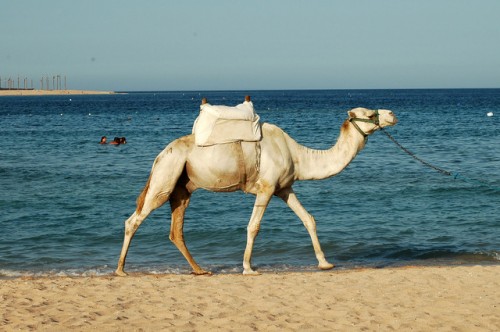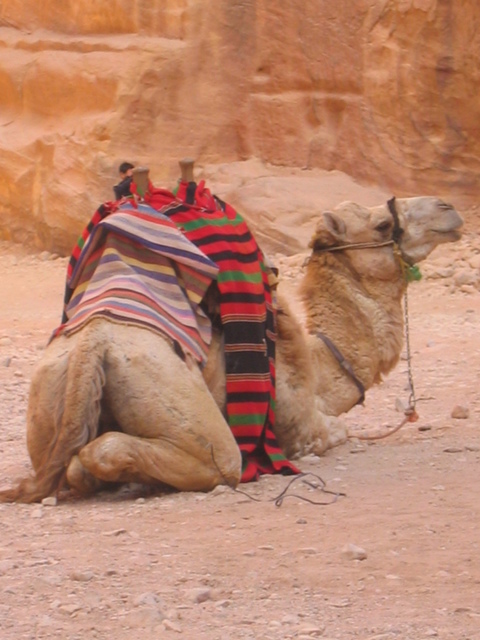|
CAMELS >> Stern and Unpitying Mind
 Another animal most important for transportation under certain circumstances is the camel. An excellent account of him is given by Mr. Wood, from which I will quote at some length, because we have so little personal acquaintance with the animal, though the mental character which he symbolizes is much more familiar. I will premise that the camel is fitted for its desert life especially by its power of storing nourishment in its hump and water in one of its stomachs, so that for several days at a time it can journey comfortably with small supplies of both. Another animal most important for transportation under certain circumstances is the camel. An excellent account of him is given by Mr. Wood, from which I will quote at some length, because we have so little personal acquaintance with the animal, though the mental character which he symbolizes is much more familiar. I will premise that the camel is fitted for its desert life especially by its power of storing nourishment in its hump and water in one of its stomachs, so that for several days at a time it can journey comfortably with small supplies of both.
Mr. Wood continues:
The food of the camel is very simple, being, in fact, anything that it can get. As it proceeds on its journey, it manages to browse as it goes along, bending its long neck to the ground, and cropping the scanty herbage without a pause. Camels have been known to travel for twenty successive days, passing over some eight hundred miles of ground, without receiving any food except that which they gathered for themselves by the way.
The favorite food of the camel is a shrub called the ghada, growing to six feet or so in height, and forming a feathery tuft of innumerable little green twigs, very slender and flexible. It is so fond of this shrub that a camel can scarcely ever pass a bush without turning aside to crop it; and even though it be beaten severely for its misconduct, it will repeat the process at the next shrub that comes in sight. It also feeds abundantly on the thorn bushes which grow so plentifully in that part of the world; and though the thorns are an inch or two in length, very strong, and as sharp as needles, the hard, horny palate of the animal enables it to devour them with perfect ease.
This is the manner of feeding; however, only in crossing the desert and when more nourishing food cannot be had. At other times it is well fed, and it is essential to a successful journey that at the start it be in good flesh, with a full, firm hump of fat. These advantages would be useless without another—i.e., the foot. The mixed stones and sand of the desert would ruin the feet of almost any animal, and it is necessary that the camel should be furnished with a foot that cannot be split by heat like the hoof of a horse, that is broad enough to prevent the creature from sinking into the sand, and is tough enough to withstand theaction of the rough and burning soil. Such a foot does the camel possess. It consists of two long toes resting upon a hard elastic cushion with a tough and horny sole. . . . Owing to the division of the toes, it spreads as the weight comes upon it, and thus gives a firm footing on loose ground. . . . In consequence of this structure, the camel sinks less deeply into the ground than any other animal. . . . It is popularly thought that hills are impracticable to the camel, but it is able to climb even rocky ground from which a horse would recoil.
The ordinary camels are large and clumsy; but in the eyes of an Arab a good deloul, or dromedary, “is one of the finest sights in the world.”The limbs of the deloul are long and wiry, havingnot an ounce of superfluous fat upon them, the shoulders are very broad, and the hump, though firm and hard, is very small. . . . Instead of plodding along at the rate of three miles an hour, which is the average speed of the common camel, the deloul can cover, if lightly loaded, nine or ten miles an hour, and go on at the same pace for a wonderful time, its long legs swinging and its body swaying as if it were but an animated machine. Delouls have been reported to have journeyed for nearly fifty hours without a single stop for rest, during which time the animals must have traversed nearly five hundredmiles. Such examples must, however, be exceptional,implying, as they do, an amount of endurance on the part of the rider equal to that of the animal, and even a journey of half that distance is scarcely possible to ordinary men on delouls.
The stern gravity of the camel’s character is most strikingly shown by its young, of which it is said that it is not one whit more playful than its parents.
Unlike almost all other animals, the camel seems to have no idea of play, and even the young camel of a month or two old follows its mother with the same steady, regular pace which she herself maintains.
 The camels know their master well, some of them being more affectionate than others. But they are liable to fits of strange fury, in which case even their own masters are not safe from them. They are also of a revengeful nature, and have an unpleasant faculty of treasuring up an injury until they can find a time of repaying it.” The camels know their master well, some of them being more affectionate than others. But they are liable to fits of strange fury, in which case even their own masters are not safe from them. They are also of a revengeful nature, and have an unpleasant faculty of treasuring up an injury until they can find a time of repaying it.”
Several instances are related by travelers of the cruel murder of their masters by camels in revenge for harsh treatment, after days of delay. Still, it is not a clever animal. If its master should fall off its back, it never dreams of stopping, as a well-trained horse would do, but proceeds at the same plodding pace, leaving his master to catch it if he can. Should it turn out of the way to crop some green thorn bush, it would go on in the same direction, never thinking of turning back into the right road unless directed by its rider.
Should the camel stray, “it is a thousand to one that he will never find his way back to his accustomed home or pasture, and the first man who picks him up will have no particular shyness to get over; . . . the losing of his old master and of his former cameline companions gives him no regret, and occasions no endeavor to find them again.”
The camel never makes way for anyone, its instinct leading it to plod onward in its direct course. Through innate stupidity, according to Mr. Palgrave, it goes straight forwards in the direction to which its head happens to be pointed, and is too foolish even to think of stopping unless it hears the signal for halt.
It is no kindly charity that is thus described, nor gentle spiritual affection for truth. It is a stern mind, comprehensive in its grasp of natural principles, unpitying and unwearying in its application of them. It is a mind that applies general principles regardless of their particular consequences. (Arcana Coelestia #2781, 3048) It is the faculty which trains youth for physical contests through hardship and severe discipline. It is the reformer who would cut off abuses by sweeping laws heedless of the injuries which they must also inflict. It is John the Baptist, who came, as his name implies, to cut off the abuses of life into which the Jews had fallen, and compel them to straight, honest, upright ways in which the Lord could come to them. A fearless rebuker of king, soldiers, Pharisees, and common people alike, he was clothed in camel’s hair, he lived in the wilderness, and braved the death which his own righteous severity provoked.
The camel lives in the desert because the camel-mind cares not to produce, but to destroy the growth of abuses; it thrives upon hard, negative prohibitions, where others would starve for want of pleasant, kindly words and acts. He chews the cud, because such a mind meditates upon and generalizes all its knowledge. He does not divide the hoof because it does not consider the kindliness and usefulness of its steps; it cares only for their rightfulness. The breadth of the foot is its power of generalizing the facts upon which it depends. His water stomach is its ample memory of cleansing truth; his hump the memory of the good results of discipline and reform.
Author: JOHN WORCESTER 1875
|
|